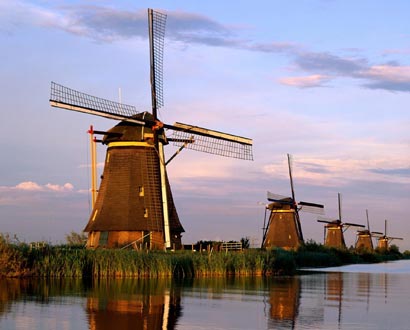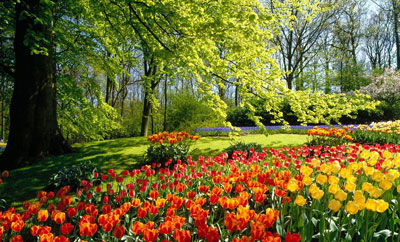Netherlands
Country statistics

Land area: 13,104 sq miles (33,939 sq km)
Total area: 16,033 sq miles (41,526 sq km)
Population (2010 est.): 16,783,092 (growth rate: 0.4%); birth rate: 10.3/1000; infant mortality rate: 4.7/1000; life expectancy: 79.4; density per sq km: 491
Capital City: Amsterdam
Monetary unit: Euro (formerly guilder)
Languages: Dutch, Frisian (both official)
Ethnicity/race: Dutch 83%, other 17% (9% of non-Western origin, mainly Turks, Moroccans, Antilleans, Surinamese, and Indonesians) (1999 est.)
Religions: Roman Catholic 31%, Dutch Reformed 13%, Calvinist 7%, Islam 6%, none 41% (2002)
Country introduction

The Netherlands is located mainly in North-west Europe and with some islands in the Caribbean. Mainland Netherlands borders the North Sea to the north and west, Belgium to the south, and Germany to the east, and shares maritime borders with Belgium, Germany and the United Kingdom.
The word Netherlands means the 'Low Lands' because the country in part is reclaimed from the waters of the North Sea and 60% of the people live below sea level. This flat land has very few hills and is cross crossed with many rivers, dykes, canals and the fertile reclaimed land known as polders. Much of the land is so low that huge walls called dykes are used to hold the sea back. There are also the beaches on the North Sea coast, the forests of Arnham and the bulb fields to the west, the central lakes and some long and impressive coastal sand dunes.
The Northern Netherlands is the least densely populated area of the region, popular with the locals but relatively unexplored by visitors. The Eastern Netherlands is home to the Hoge Veluwe National Park, the largest park in the Netherlands, as well as medieval cities such as Zutphen and Doesburh. The Southern Netherlands around Zeeland offer a more German atmosphere, this is also a popular party region. The Randstand or Western Netherlands includes North and South Holland, Flevoland and Utrecht, an area which is home to some of the biggest cities and some traditional countryside.
The weather is moderate and despite being over populated, the flat geography explains why people in the Netherlands (called the Dutch) are so keen on cycling, and is also the reason for some of the Netherlands' best-known landmarks, windmills.
The culture

With a population of over 16 million in such a small country, efficient planning is an essential way of life in the Netherlands. Planning, regulating and organizing are of major importance to the Dutch.
Universal rules and regulations in society, combined with good internal discipline, bring stability to life and reduce uncertainty. There is a strong need for social and personal order. Equal rights for everyone are guaranteed by law here and forms a central principle of Dutch society.
When socialising, the Dutch enjoy visiting bars and cafés, and cinemas are also very popular. They are keen on sport and fitness, music, social clubs and organised events. They also love flowers - Dutch homes are often full of houseplants, and bunches of flowers are frequently given as gifts when visiting friends or relatives.
Attractions & landmarks

The Dutch are very proud of their heritage and how it is reflected in their modern architecture. Many of the buildings of Amsterdam, Rotterdam, Eindhoven and Dordrecht date back before the first world war. The Rietveld Schröder House is located in the northern town of Utrecht. Constructed in 1924, the building is considered a pioneering work of modernism.
Some say Amsterdam's most famous icon is the tulip; these flowers cover acre upon acre of the Dutch countryside and make for a romantic escape from the hustle and bustle of the country's larger cities. Keukenhof features nearly 80 acres of flower fields along with guided tours, bike rentals, indoor flower farms and boat tours.
The country is famous for their windmills, which were used to mill corn, drain flooded land and eventually generate electricity. Kinderdijk, a small village outside Rotterdam, features 19 windmills used for pumping water. This village dates back to the 16th century. One windmill is open to the public and often in operation. The windmills at Zaanse Schans, still used in the production of paint components, mustard and cooking oil, offers guided tours and a museum.
Named one of the Seven Wonders of the Modern World by the American Society of Civil Engineers, the Delta Works, or Deltaweken, began construction in 1958 to ensure the safety of the Dutch countryside during floods. The works consist of dams, sluices, locks, dikes, and storm surge barriers. The aim of the dams, sluices, and storm surge barriers was to shorten the Dutch coastline, thus reducing the number of dikes that had to be raised. Visitors have the opportunity to see the dams and learn about the area's history from multiple museums. Located in the south-western corner of the country, the area is covered with rolling meadows and popular among hikers and cyclists.
The capital is a city of stunning 17th century canals, bridges, bikes and rich culture with unmissible museums such as the Van Gogh museum and Rijksmuseum, housing Rembrandt's famed painting, The Night Watch.